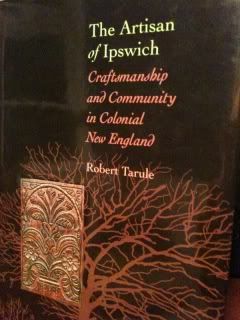The Artisan of Ipswich

Last month while attending WIA in Valley Forge I was fortunate enough to get some time to chat with Peter Follansbee about sources to learn more about 17th century furniture. Peter highly recommended Dr. Robert Tarule’s book “The Artisan of Ipswich” about the Ipswich, MA joiner Thomas Dennis. If you are only slightly interested in learning about how it was done in 17th century America then this book is for you. Not only do we get a bench side view of a chest being built but Dr. Tarule spends a copious amount of time telling us about the history of the settling of Ipswich and how the native Americans practiced sustainable forestry that provided the colonists with such a bounty of resources. In addition, there is an entire chapter devoted to the other artisans throughout the town like Coopers, Carpenters, and Wheelwrights and a discussion about the types of wood they needed and how they impacted on the resources available to the commoners of Ipswich.
I admit to being a bit of a history buff, but when you combine my love of woodworking with a study on the workings of a colonial town you get a great read. Dr. Tarule uses a mixture of non fiction, footnoted writing typical of a doctoral thesis, but then he slips into his side by side retelling of Thomas Dennis making a chest for a patron. What is most interesting is that Tarule’s retelling is not conjecture but highly accurate based on his examination of the actual piece being described. By following the tool marks, scribe lines, and reading the wood, Dr. Tarule can recreate how the joiner made this piece.

A shot of Peter Follansbee’s work from WIA Tools & Techniques 2009
By the end of the book, you are better informed not only of how you take a tree and make a chest, but why it was done that way, and what sociological pressures forced it to be designed the way it was. Finally as a parting treat, Dr. Tarule’s epilogue follows this same chest up through ages to it’s modern day home in a museum in Massachusetts. It puts a nice little bow on your understanding of the piece and how it has weathered the storm of time.
In short, go find a copy of this book. Prices has gone up a bit since Chris Schwarz blogged about it a few weeks ago, but there are still many used sources out there and you will thank me once you have read it.


